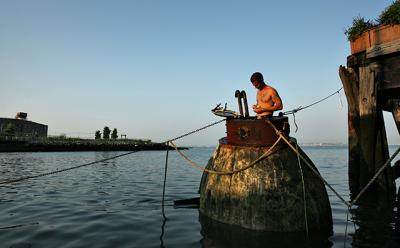Offshore Art Sails Into Parrish

For the past several decades, a movement has been taking shape under the radar of the art world and even the artists within it. That will change with the opening this weekend of the Parrish Art Museum’s “Radical Seafaring,” a pioneering exhibition and catalog produced by Andrea Grover that seeks to define “offshore art.”
Ms. Grover, whom the artists and East End community at large have come to think of as their social chairwoman for the events she organizes such as PechaKucha evenings and the Parrish Road Show, has been working on this exhibition for several years. She started in Houston and then gathered inspiration from the South Fork environment, even including a few regional artists she has met along the way.
The result is a collection of 25 artists from five countries and a snapshot of a more encyclopedic exhibition in years to come.
“It is the exhibition I was born to curate,” she said last week, only half joking. Her father owned a marina and was a commercial fisherman for more than 50 years, and her mother was an artist. Growing up in this environment made her sensitive to the two aesthetics, she said, and receptive to them merging when she saw it happening in front of her eyes.
“I had my own motorboat at 15, before I even had a car.” She used it to traverse the water around her house in Freeport, where she grew up. She moved from Houston to Sag Harbor in 2011, when she was invited by Terrie Sultan, the Parrish’s director, to join the staff.
Ms. Sultan knew Ms. Grover from her various projects in Houston, which grew out of the Aurora Picture Show, a nonprofit arts venture she started in her living room that “became synonymous with roaming, multidisciplinary art platforms,” as she told The Star in 2013. Diane Shamash, who was known for integrating art projects with urban waterways, came to Houston to draw residents’ attention to its bayous with a barge that was designed to travel along the waterfront while projecting film footage of landscapes. The barge and project literally ran aground on its maiden voyage, but a seed was planted.
Beginning with Bas Jan Ader, whose own conceptual project on crossing the North Atlantic also ended in failure and his assumed death, she began to take note of artists whose practices incorporated the sea. Those she found tended to fall into more traditionally defined categories of land art, conceptual art, and performance art. Yet, more and more artists and their projects revealed themselves. She kept a mental catalog until it reached, as she put it, critical mass and she knew it was time to organize an exhibition.
As the recreational use of urban waterways declined and access to them diminished, they became forgotten and in many places lawless, “a no-man’s-land, but an interesting conceptual space, fluid in every sense of the word,” she said. The exhibition’s four thematic categories include Exploration, Liberation, Field Work, and Speculation.
Explorers, who have challenged their abilities to navigate the natural world, have included Mr. Ader and Chris Burden, who took a solo journey by kayak in Mexico in 120-degree heat. An assumption about such work is that the only remnants would be photo documentation. But such expectations of the banal are quickly pushed aside. Mr. Burden’s journal, along with a seashell and stone, are the markers here. Mr. Ader’s 1975 work is represented by a contemporaneous recording and 80-slide projection of a chorus singing a sea chantey.
Contributing to the Liberation (or the escape from the law of the land) theme is Atelier Van Lieshout, which documents the work of Women on Waves, a Dutch nonprofit that provides clinical abortions off the coast of countries that do not allow them.
Field Work celebrates those who take part in research projects and create art related to them. Steve Badgett and Chris Taylor, as part of the Center for Land Use Interpretation, built a pontoon boat to collect data in the shallows of the Great Salt Lake the way painters might create plein air canvases. A model of the boat and a documentary photograph of them in it make up their section of the show.
The Speculation theme covers visionaries such as Buckminster Fuller, who designed offshore residential islands as a way to address the housing crisis in the 1960s. His models will be on view.
Homegrown or transplanted artists to the area in the show include Scott Bluedorn from Amagansett, Courtney Leonard, who grew up on the Shinnecock Reservation, Michael Combs, whose family’s connections to the North Fork date to the 17th century, Dennis Oppenheim, and Gordon Matta-Clark.
After a members reception on Sunday, the show will open to the public at 1 p.m. Special events include the docking of Mary Mattingly’s “WetLand,” a modified houseboat that demonstrates various sustainable living practices, at Long Wharf in Sag Harbor. It will be open on the weekends of May 14 and May 21 from 11 a.m. to 4 p.m. On May 21, an all-day series of talks and performances tied to the regional landscape, called the “Tideland Sessions,” will be presented. On June 17, there will be a reading of “Men’s Lives,” a play written by Joe Pintauro based on Peter Matthiessen’s book about the East End’s fishing community. The exhibition will remain on view through July 24.
